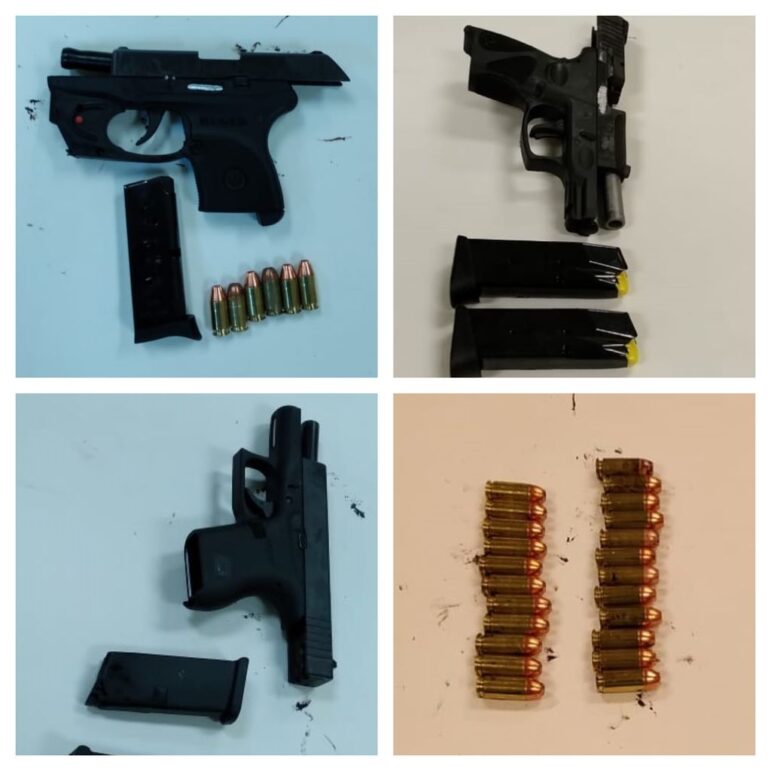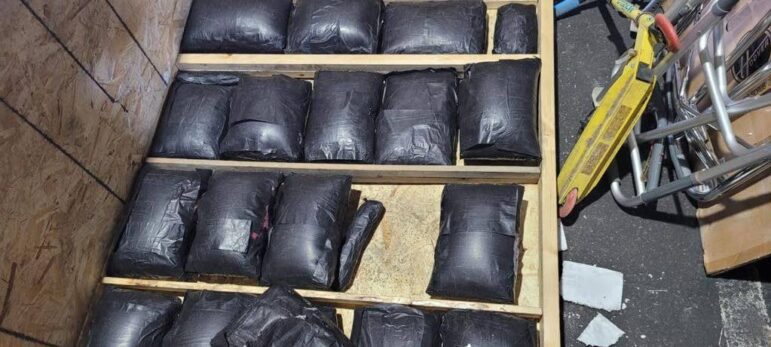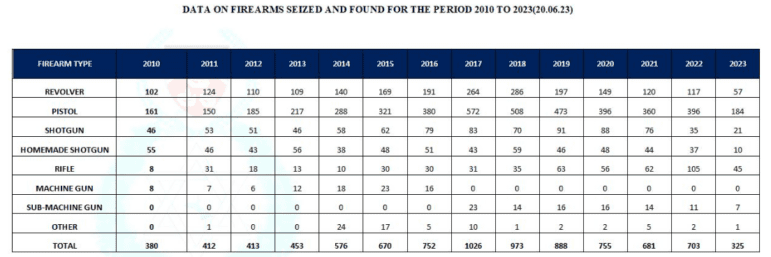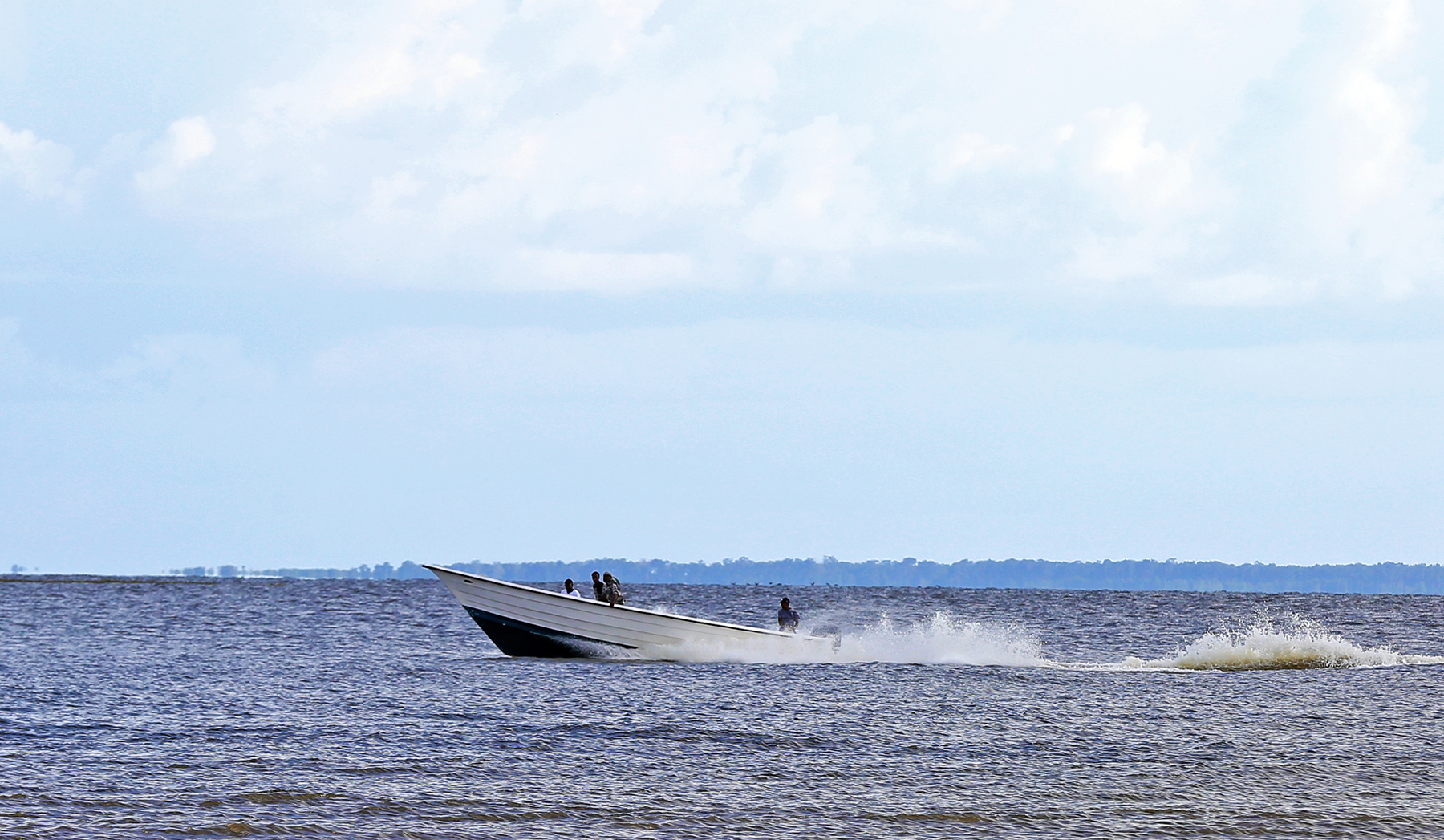Port of Spain, Trinidad – Back in 2018, Tommy (not his real name) and four other men attempted to rob a restaurant in Arima – a bustling borough in east Trinidad that’s home to 65,000. When the smoke cleared, a single bullet had taken the life of the cashier on duty.
Five years later, Tommy recalls the tragedy as if it were yesterday: Two guns, a resistant restaurateur, a single shot, the shuffle of escape, cash in hand, but cameras that captured each stage of the fateful event. It cost him three years in prison.
The police later found that the guns in question were 9mm pistols – a weapon of choice for T&T criminals. Murders, robberies, extortion, and other acts of threatened and actual violence all appear to favour the use of this weapon.
Since 2010, the police have seized 4,591 such weapons. They are aware that the path to such discoveries is a long, winding one often with origins outside the borders of the twin-island republic.

Tommy thinks he has a handle on the transport route. In his interview with CIJN he says he knows his case began in Venezuela – under 20 kilometres west of Trinidad. By boat, and depending on the vessel used, the trip can take between two and three hours – not including time to elude authorities from both nations.
According to the Trinidadian convict, a network exists to facilitate the flow of guns, ammunition and other contraband between Tucupita, a city in north-eastern Venezuela, and a number of coastal drop-off points in Trinidad.
“They don’t trade money,” he says. “They want things they hardly get (in embargo-affected Venezuela)” he explained.
“Once you know where in the underworld you can get it to buy, it’s easy,” the CIJN source says. He paid close to US$4,000 for his 9mm. Depending on the calibre, the price can start from US$2,000 per weapon.
T&T authorities have been having a close look at the sources of weapons that, in 2022, cost most of the country’s record-breaking 605 lives. With a population of under 1.5 million, such a murder toll has generated substantial public and political concern.
National security minister, Fitzgerald Hinds, has surmised that illegal firearms appear too easy to acquire. A 2022 Strategic Services Agency (SSA) report indicated that there were as many as 12,000 illegal guns in the country. And though there is parallel concern about the acquisition of legitimate firearms users’ licences, “the focus has to be on these illegal weapons.”

Former police commissioner, Gary Griffith – also a former national security minister who has fallen under scrutiny for his role in the granting of firearms licences – believes the transportation networks and routes don’t have to be that elaborate.
“It’s all the major, legitimate ports of entry especially of container ships that come from primarily North America like the ports of Miami and New York,” Griffith rold CIJN.
Those “legitimate” ports of entry in the north and south of the island, including Point Lisas, King’s Wharf or Queen’s Wharf. He estimated that up to 95 per cent of the country’s illegal firearms enter through these ostensibly heavily policed ports.
In mid-July, customs officials discovered a cache valued in the order of US$51,622. This included firearms, ammunition, firearms parts and other accessories detected at a transit shed at the bustling Port of Port of Spain.
The shipment had arrived from the United States, the point of departure for an estimated 90 per cent of illegal firearms. One typical strategy, security officials say is widely employed, is the dismantling of guns into different pieces and concealment in appliances such as washing machines and refrigerators.
While the police service itself frequently finds itself in the firing line over such breaches, protocols require acquisition of a court warrant in order that officers conduct searches at the various ports.
Last November, acting Deputy Comptroller of Customs and Excise, Yasmin Harris complained of a shortage of staff to conduct comprehensive, ongoing investigations and searches. She also told a Joint Select Committee of Parliament of a shortage of operational scanners – “We now have operational only the fixed scanner at the Port of Port of Spain and for January to August we scanned 3,998 out of 23,000 (containers).”
“It is like you drop your car keys somewhere along a street but you decide to only look under the streetlight hoping you will find it,” Griffith remarked. He believes it is possible to check every container that enters the country.
He however suggests that intelligence is also key, and that liaising with security officials in places like Miami and New York can lead to information as it pertains to criminal elements or persons of interest in the illegal trafficking of guns.
With other Caribbean nations facing similar struggles, a frustrated CARICOM leadership has more than once confronted the United States on the influx of its weapons in the region on separate occasions.
At the 45th CARICOM Heads of Government Meeting in Port of Spain in July, US Secretary of State, Antony Blinken welcomed the creation of a CARICOM Crime Gun Intelligence Unit.
He also revealed that the US government had created a new position at the Department of Justice “to deepen collaboration among us on gun prosecutions.”
Statistics from the Crime and Problem Analysis Branch (CAPA) of the T&T Police Service, spanning the period 2015-2022, show that the range of crimes involving firearms was wide and varied.
Firearm related offences include wounding and shootings, robberies and the possession of firearms. It peaked in 2020 when there was a total of 2,901 firearm related offences of which the majority (1,747) were robberies. That trend has continued since then with more firearm-related robberies than murders and woundings.

The number of firearms seized at legal ports of entry over the last eight years does not compare with the 12,000 guns the SSA believes are on the streets. Only nine firearms were seized between 2015 and 2020.
In 2021, there were 38 seizures, 30 of which were found at the Swissport Cargo Bond of the Piarco International Airport. Of the 38 seizures, 21 firearms were pistols while 15 were rifles.
In 2022, 52 firearms were seized. Of that number, 42 were rifles and 10 were pistols. The major find was at Medway Shipping Complex/Warehouse – major private facility in central Trinidad where 45 firearms were discovered.
Based on the data from CAPA, rifles and pistols are among the most seized weapons in T&T since 2010. Over the last 12 years, 2,078 revolvers were seized by the TTPS including 57 so far this year.
When it comes to pistols, more than twice the number of revolvers were found for the same period; 4,591. Of that figure, 184 pistols have been up to July this year. The last seizure of machine guns in this country was in 2016, but the police have regularly seized sub-machine guns – 101 between 2016 and 2023.

And while there might be startling statistics over illegal firearms, legal ones have also become a concern. At the start of May, police commissioner Erla Harewood-Christopher revealed in a sworn High Court statement that over 100 guns granted under three former police commissioners – Stephen Williams, Gary Griffith and McDonald Jacob – were used to commit crimes of murder, robberies and suicides.
Additionally, intelligence from the US Bureau of Alcohol, Tobacco, Firearms and Explosives (ATF) suggests that 30 guns imported by authorised gun dealers in T&T ended up in the hands of criminals and were used to commit murder.
Security expert, Luke Hadeed, says the situation calls for effective management and consistency from the security apparatus. “Crime is a business,” he says. “It is an operation. It is an organisation that is no different than any other.”
He says there is evidence to suggest the authorities are being strategic and tactful, but “we need to be consistent and that consistency is required for all of the solutions, methods and techniques that have been developed towards reducing the ills through effective enforcement in detection and prosecution.”
For Tommy, now out of prison and committed to a different kind of life, a proper “public health” approach to resolving the issue of criminal violence should focus on “resources and intervene in violence while also meditating disputes before violence can occur.”
He found out the hard way that gun stories more often than not, do not end very well.
